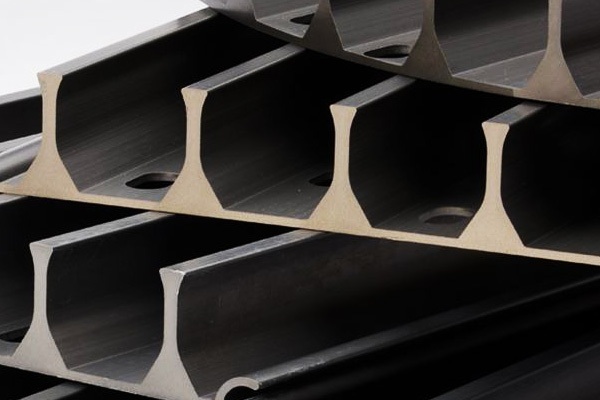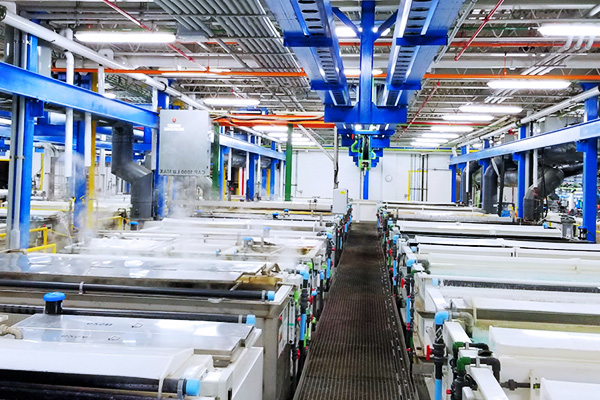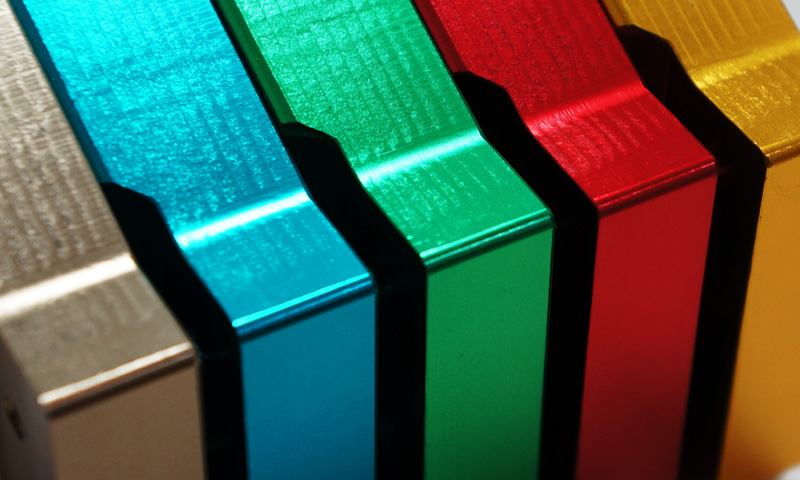1. Zavedení
Eloxování je široce používaný proces, který zlepšuje vlastnosti hliníku, dělat to odolnější, odolné vůči korozi, a vizuálně přitažlivé.
Běžně se používá v průmyslových odvětvích, jako je letecký průmysl, automobilový průmysl, a elektronika, kde hliníkové díly musí fungovat v náročných prostředích.
Však, možná vás budou zajímat náklady spojené s eloxováním hliníkových dílů.
Eloxovaný hliník cena závisí na několika faktorech, od typu eloxování hliníku, který používáte, až po tloušťku povlaku, rozměr dílu, A další.
Jakmile zjistíte tyto faktory, můžete odhadnout správné náklady na eloxování hliníku.
V tomto blogu, rozebereme různé proměnné, které ovlivňují ceny eloxování, a pomůžeme vám lépe pochopit, co můžete očekávat, když si vyžádáte díly z eloxovaného hliníku pro svůj další projekt.
2. Co je eloxovaný hliník?
Definice
Eloxování je elektrochemický proces, který zlepšuje přirozenou oxidovou vrstvu na hliníkových površích.
Ponořením hliníku do kyselé elektrolytické lázně a průchodem elektrického proudu, dochází k řízené oxidaci, vytváří ochranný a dekorativní povrch.
Tato metoda nejen zvyšuje tloušťku vrstvy oxidu, ale také integruje barvu přímo do kovu, zajišťující dlouhou životnost.

Klíčové výhody
- Odolnost proti korozi: Zesílená vrstva oxidu chrání před rzí a jinými formami koroze, prodloužení životnosti hliníkových výrobků.
- Zvýšená estetická přitažlivost: Dostupné ve spektru barev a povrchových úprav, eloxovaný hliník může výrazně zvýšit vizuální přitažlivost produktů.
- Lepší odolnost proti opotřebení: Tvrzený povlak zlepšuje odolnost proti opotřebení, takže je ideální pro vysoce výkonné aplikace.
- Elektrická izolace: Díky nevodivým vlastnostem je eloxovaný hliník vhodný pro elektrické součástky.
Běžné aplikace
Průmyslová odvětví, jako je letectví, automobilový průmysl, elektronika, a architektura často používá eloxovaný hliník.
Například, letecké komponenty těží z lehké, ale odolné povahy eloxovaného hliníku, zatímco architektonické prvky získávají krásu i dlouhou životnost.
3. Faktory ovlivňující náklady na eloxovaný hliník
Náklady na eloxování hliníku se mohou výrazně lišit v závislosti na několika faktorech. Pochopení těchto prvků pomáhá přijímat informovaná rozhodnutí, která vyvažují rozpočtová omezení s požadavky na kvalitu.
Pojďme se hlouběji ponořit do klíčových faktorů, které ovlivňují náklady:
Typ procesu eloxování
Různé typy anodizačních procesů vyhovují různým potřebám aplikací, každý se svými dopady na náklady.
- Typ II (Eloxování kyselinou sírovou): Toto je nejběžnější a nejhospodárnější metoda, vhodné pro všeobecné použití. Poskytuje povlak střední tvrdosti a tloušťky v rozmezí od 5 na 25 mikronů.
Proces je rychlejší a méně energeticky náročný ve srovnání s eloxováním tvrdým povlakem, dělat to dostupnější.
Například, Eloxování typu II může přidat pouze 0,50 až 0,50na1.00 za čtvereční stopu k ceně dílu.

- Typ III (Eloxování tvrdého povlaku): Navrženo pro aplikace s vysokým opotřebením, tento proces vytváří silnější a tvrdší povlaky, obvykle mezi 25 na 75 mikronů.
Zvýšená tloušťka a tvrdost jsou spojeny s vyššími náklady v důsledku delší doby zpracování a vyšších energetických nároků.
Eloxování typu III může prodloužit dobu výroby až o 50% ve srovnání s typem II, což vede k rozdílu v nákladech přibližně 20-40%.
Navíc, dosažení jednotné vrstvy tvrdého povlaku často vyžaduje specializované vybavení a odborné znalosti, další přidání do nákladů.

Tvrdost a tloušťka eloxovaných vrstev
Tvrdost a tloušťka eloxované vrstvy přímo ovlivňuje trvanlivost a výkon hotového výrobku.
Silnější vrstvy nabízejí lepší ochranu, ale jejich výroba vyžaduje více času a zdrojů. Například, zvýšení tloušťky od 25 mikronů až 50 mikronů může zvýšit náklady 25-50%.
Materiál a velikost hliníkové části
Rozměry a materiálové složení hliníkových dílů hrají zásadní roli při určování nákladů na eloxování.
- Tloušťka a plocha povrchu: Větší a tlustší díly vyžadují více materiálu a delší dobu zpracování, což zvyšuje náklady.
Například, měření dílu 1 palec tlustý může stát 25-50% více než část stejných rozměrů, ale pouze 0.5 palce tlusté.
Podobně, díly s větším povrchem budou dražší, protože vyžadují více roztoku elektrolytu a dobu zpracování. - Materiálové složení: Různé hliníkové slitiny reagují na eloxování různě. Některé slitiny, jako 6061-T6, snadněji se eloxují, a proto jsou levnější.
Ostatní, například 7075, může vyžadovat další kroky předúpravy nebo úpravy v procesu eloxování, zvýšení nákladů.
Dávka vs. Vlastní eloxování
Strategie objednávek také ovlivňuje celkové náklady.
- Hromadné objednávky: Hromadné objednávky těží z úspor z rozsahu, snížení jednotkových nákladů. Objednávka v dávkách může snížit jednotkové ceny až o 60%.
Například, objednávání 500 jednotek místo 100 může výrazně snížit náklady na jednotku.
Hromadné objednávky umožňují optimalizované využití materiálů a zkrácení doby přípravy, převést na úspory. - Vlastní jednorázové eloxování: Vlastní objednávky zahrnují vyšší poplatky za nastavení a zpracování kvůli potřebě jedinečného nářadí, maskování, a potenciálně nestandardní velikosti nebo tvary.
Jeden zakázkový kus může stát 125, zatímco objednávání 1 0 kusy by mohly zvýšit náklady na 125,
zatímco objednávání 10 kusy by mohly snížit náklady na 12 za kus, předvedení nákladové efektivity dávkového zpracování.
Barvení Eloxování
Barevná anodizace zahrnuje další kroky, které zvyšují náklady.
- Barvené eloxování: Přidání barvy barvením vyžaduje další kroky zpracování pro barvení a těsnění, což může zvýšit náklady 30-50% ve srovnání s čirou anodizací.
Například, černé eloxování může přidat přibližně 1,00 až 1,00na1.50 na čtvereční stopu k základním nákladům na čistou anodizaci.

Možnosti dokončení
Dokončovací úpravy mohou zlepšit vzhled a funkčnost eloxovaného hliníku, ale mají svou cenu.
- Leštěné nebo kartáčované povrchy: Tyto povrchové úpravy zvyšují pracnost a zpracování, zvýšení konečné ceny.
Leštěné povrchy, například, může přidat 10-20% na náklady v důsledku pečlivé práce potřebné k dosažení hladkého průběhu, Reflexní povrch.
Zeměpisná poloha
Místo hraje významnou roli v cenách kvůli rozdílům v mzdových nákladech, regulační normy, a dostupnost služby.
- Regionální rozdíly: Anodizační služby v Severní Americe mohou být 20-30% dražší než v Asii kvůli vyšším nákladům na pracovní sílu a přísnějším ekologickým předpisům.
Naopak, regiony s nižšími náklady na pracovní sílu a méně regulačními překážkami mohou nabídnout konkurenceschopnější ceny.
4. Typické náklady na eloxovaný hliník
Pochopení typických nákladů na eloxovaný hliník je zásadní pro rozpočtování a rozhodování v projektech od malých zakázkových kusů až po velkovýrobu.
Cena se může značně lišit v závislosti na faktorech, jako je typ procesu eloxování, rozměry dílu, velikost šarže, a možnosti dokončení.
Níže, poskytujeme komplexní přehled cenového rozpětí pro eloxovaný hliník, spolu s konkrétními příklady pro ilustraci těchto nákladů.
Přehled cenového rozpětí
Cena za čtvereční stopu
- Jasné eloxování:
-
- Standardní díly: Čirá anodizace pro standardní díly obvykle stojí mezi 0,50 a 0,50a0.75 na čtvereční stopu.
Například, hliníkový panel standardní velikosti 1 čtvereční stopa by stála přibližně $0.75 pro čirou anodizaci. - Vlastní tvary: Díly na zakázku mohou zvýšit náklady až o 40%. Kus na míru může stát kolem $1.00 na čtvereční stopu.
- Standardní díly: Čirá anodizace pro standardní díly obvykle stojí mezi 0,50 a 0,50a0.75 na čtvereční stopu.
- Barevné eloxování:
-
- Společné barvy (Černý, Modrý, Červený): Barevné eloxování obvykle přidává o 30-50% k ceně ve srovnání s čirou anodizací.
Například, černé eloxování by mohlo stát kolem $2.25 na čtvereční stopu. - Speciální barvy: Jedinečné nebo vlastní barvy mohou vyžadovat speciální barviva a procesy, další zvyšování nákladů. Lze přidat speciální barvy 50-100% k základní ceně.
- Společné barvy (Černý, Modrý, Červený): Barevné eloxování obvykle přidává o 30-50% k ceně ve srovnání s čirou anodizací.
- Hardcoat (Typ III) Eloxování:
-
- Silné nátěry: Tvrdá anodizace, který poskytuje silnější a tvrdší povlak, obecně náklady mezi 2.00 a 6.00 na čtvereční stopu.
Silnější vrstvy, jako jsou ty překračující 50 mikronů, může posunout náklady ještě výš. - Vysoce výkonné aplikace: Pro aplikace s vysokým opotřebením, jako jsou součásti leteckého průmyslu, tvrdá anodizace zajišťuje vynikající odolnost, ale je prémiová.
Tyto specializované nátěry mohou stát i více $6.00 na čtvereční stopu.
- Silné nátěry: Tvrdá anodizace, který poskytuje silnější a tvrdší povlak, obecně náklady mezi 2.00 a 6.00 na čtvereční stopu.
Dodatečné náklady
Kromě základního procesu eloxování, celkové náklady může ovlivnit několik dalších faktorů:
- Vlastní velikosti a tvary: Nestandardní rozměry nebo tvary často vyžadují vlastní nástroje a nastavení, přidání k celkovým nákladům. Vlastní díly mohou zvýšit náklady 20-40%.
- Specifická léčba: Předúpravy, jako je tryskání, leštění, nebo maskování může přidat další práci a čas na zpracování.
Například, tryskání může přidat 0,50 až 0,50na1.00 za čtvereční stopu k ceně. - Možnosti dokončení: Leštěné nebo kartáčované povrchy zlepšují vzhled, ale také zvyšují náklady. Leštění lze přidat 10-20% k celkovým nákladům.
5. Tipy pro vytváření vysoce kvalitních dílů z eloxovaného hliníku
Dosažení vysoce kvalitních dílů z eloxovaného hliníku vyžaduje pečlivé zvážení materiálů, procesy, a možnosti dokončení.
Níže jsou praktické tipy, jak zajistit nejlepší možný výsledek pro vaše projekty z eloxovaného hliníku:
Získejte správné materiály
- Vyberte si vhodné hliníkové slitiny: Výběr správné hliníkové slitiny je zásadní pro dosažení optimálních výsledků při eloxování.
Například, 6061-Hliník T6 je široce používán díky svým vynikajícím mechanickým vlastnostem a vynikající reakci na eloxování.
Tato slitina nabízí dobrou odolnost proti korozi a jednotnou povrchovou úpravu, Díky tomu je ideální pro aplikace vyžadující jak estetiku, tak odolnost. - Zvažte čistotu materiálu: Hliníkové slitiny s vyšší čistotou mají tendenci vytvářet konzistentnější a esteticky příjemnější povrchové úpravy.
Nečistoty mohou vést k nerovnoměrným nátěrům nebo ke změně barvy. Zajištění toho, že materiál má nízký obsah nečistot, může zlepšit kvalitu eloxovaného povrchu.
Optimalizujte proces eloxování
- Rozumět chemii: Chemie anodizačního roztoku hraje rozhodující roli v kvalitě konečného produktu.
Správná hladina pH, koncentrace elektrolytů, a kontrola teploty jsou zásadní pro dosažení jednotného a odolného povlaku.
Pravidelné testování a úpravy mohou pomoci udržet optimální podmínky během celého procesu. - Ovládání teploty a napětí: Udržování stálých teplot a úrovní napětí během eloxování zajišťuje rovnoměrnou tloušťku povlaku.
Odchylky mohou vést k nekonzistentním výsledkům a vyšší míře odmítnutí. Pokročilé monitorovací systémy mohou poskytovat data v reálném čase a pomoci operátorům rychle provést nezbytné úpravy. - Procesy předúpravy: Příprava hliníkového povrchu před eloxováním je zásadní pro přilnavost a kvalitu.
Procesy jako odmašťování, lept, a deoxidace odstraní nečistoty a připraví povrch pro lepší výsledky eloxování.
Například, otryskávání korálky může vytvořit matný povrch, který zvyšuje estetický vzhled a zároveň zlepšuje přilnavost eloxované vrstvy.
Vylepšete možnosti dokončování
- Vyberte možnost Vhodné povrchové úpravy: Výběr správné povrchové úpravy ovlivňuje nejen vzhled, ale také výkon.
Leštěné nebo kartáčované povrchy mohou výrazně ovlivnit vzhled a dojem součásti.
Leštění, například, vyžaduje pečlivou práci k dosažení hladkosti, Reflexní povrch, přidání kolem 10-20% za cenu, ale nabízí prémiový vzhled. - Konzistence barev: Důležité je dosažení barevné konzistence, zejména pro barevné eloxování.
Použití vysoce kvalitních barviv a pečetících procesů může zajistit, že barvy zůstanou živé a odolné proti vyblednutí v průběhu času.
Zvláštní pozornost by měla být věnována kroku těsnění, který uzamyká barvu a zvyšuje odolnost. - Post-eloxovací ošetření: Následná anodizační úprava, jako je těsnění nebo nanášení ochranných povlaků, může dále zlepšit trvanlivost a vzhled dílů.
Těsnění pomáhá chránit eloxovanou vrstvu před opotřebením a faktory prostředí, prodloužení životnosti výrobku.
Implementujte efektivní výrobní postupy
- Dávkové zpracování: Konsolidace více položek pro současné eloxování maximalizuje efektivitu a snižuje celkové náklady.
Dávkové zpracování může ušetřit až 20% na poplatcích za zpracování díky minimalizaci doby nastavení a maximálnímu využití zařízení. - Standardizujte velikosti a tvary: Volba standardních velikostí a tvarů minimalizuje dobu nastavení a zpracování, čímž se sníží náklady.
Standardní díly jsou obvykle dostupné za nižší ceny a kratší dodací lhůty.
Zakázkové díly, i když je to někdy nutné, může zvýšit náklady až o 40% kvůli dodatečné práci a požadavkům na specializované nástroje.
6. Jak ušetřit na nákladech na eloxovaný hliník
Hromadné objednávky
Hromadné objednávání snižuje jednotkové ceny díky úsporám z rozsahu. Například, objednávání 500 jednotek místo 100 může snížit jednotkové náklady až o 60%.
Standardní velikosti a tvary
Volba standardních dílů minimalizuje dobu nastavení a zpracování, čímž se sníží náklady. Standardní velikosti jsou obvykle dostupné za nižší ceny a kratší dodací lhůty.
Výběr materiálu
Výběr hliníkových slitin, které jsou přirozeně vhodnější pro eloxování, může pomoci snížit náklady. Například, 6061 hliník je pro eloxování cenově výhodnější ve srovnání s 7075 hliník.
Dávkové zpracování
Konsolidace více položek pro současné eloxování snižuje celkové náklady. Dávkové zpracování může ušetřit až 20% o poplatcích za zpracování maximalizací efektivity.
7. Kompromis mezi cenou a kvalitou
Trvanlivost vs. Cena
Zatímco levnější procesy eloxování se mohou zdát atraktivní, mohou ohrozit životnost, tloušťka, nebo konzistence barvy. Investice do kvalitnějšího eloxování zajišťuje dlouhodobý výkon a spolehlivost.
Estetická přitažlivost vs. Náklady
Volba mezi matným a lesklým povrchem závisí jak na rozpočtu, tak na estetických požadavcích. Lesklé povrchy jsou často drahé, přidání o 10-20% do nákladů.
8. Kdy se eloxovaný hliník vyplatí?
Dlouhodobá hodnota
I když počáteční investice může být vyšší, Prodloužená životnost eloxovaného hliníku a snížené náklady na údržbu z něj činí z dlouhodobého hlediska nákladově efektivní volbu.
Například, eloxované hliníkové panely vydrží až 20 let s minimální údržbou.
Vysoce výkonné aplikace
V odvětvích, jako je letecký a automobilový průmysl, kde jsou bezpečnost a výkon prvořadé, vysoce kvalitní eloxování je nepostradatelné.
Zvýšená životnost a odolnost proti korozi ospravedlňují vyšší počáteční náklady.
9. Jak outsourcovat váš projekt eloxování hliníku
Při outsourcingu, zvažte následující:
- Dodací lhůty: Uvědomte si, jak dlouho bude trvat dokončení vašeho projektu. Mohou se přidat kratší dodací lhůty 10-20% do nákladů.
- Minimální objednané množství (MOQ): Buďte si vědomi jakýchkoli požadavků na MOQ, což může ovlivnit cenu a proveditelnost.
- Standardní nabízené barvy: Zkontrolujte, zda poskytovatel služeb nabízí barvy, které potřebujete, protože vlastní barvy mohou zvýšit náklady až o 30%.
- Nabízená tloušťka povlaku: Ujistěte se, že mohou splňovat vaše specifikace tloušťky, protože silnější nátěry zvyšují náklady.
- Náklady: Porovnejte nabídky od různých poskytovatelů, abyste našli nejlepší hodnotu.

10. Závěr
Eloxovaný hliník nabízí vynikající ochranu a estetiku pro širokou škálu aplikací, ale náklady se mohou lišit v závislosti na několika faktorech, včetně typu procesu, materiál, velikost, a objednané množství.
Pochopením těchto faktorů a zvážením způsobů, jak snížit náklady, můžete maximálně využít výhod eloxování, aniž byste překročili svůj rozpočet.
Při rozhodování o eloxovaném hliníku pro vaše projekty vždy porovnejte nabídky a vyhodnoťte dlouhodobou hodnotu.
Časté časté
Proč zvolit eloxovaný hliník před jinými povrchovými úpravami?
Eloxovaný hliník nabízí několik výhod oproti jiným povrchovým úpravám:
- Odolnost proti korozi: Zesílená vrstva oxidu chrání před rzí a jinými formami koroze.
- Trvanlivost: Poskytuje zvýšenou tvrdost a odolnost proti opotřebení ve srovnání s neošetřeným hliníkem.
- Estetická přitažlivost: Dostupné v různých barvách a povrchových úpravách, může výrazně zvednout vizuální přitažlivost produktů.
- Nevodivé: Díky nevodivým vlastnostem je vhodný pro elektrické součástky.
- Bezúdržbový: Jednou eloxovaný, hliník vyžaduje minimální údržbu.
Eloxovaný hliník lze přebarvit nebo opravit?
Zatímco přebarvování eloxovaného hliníku je náročné, není to nemožné. Opravy lze provést odstraněním stávající eloxované vrstvy a opětovnou anodizací dílu.
Však, dosažení dokonalé shody barvy a povrchové úpravy může být obtížné.
Na drobné škrábance, Dočasnou opravu mohou poskytnout opravné barvy nebo fixy určené na hliník.
Je eloxovaný hliník šetrný k životnímu prostředí?
Ano, eloxovaný hliník je považován za ekologický. Proces nezahrnuje žádné těkavé organické sloučeniny (VOC), a výsledná oxidová vrstva je stabilní a netoxická.
Navíc, samotný hliník je recyklovatelný, dělá z eloxovaného hliníku udržitelnou volbu.
Jak dlouho vydrží eloxovaný hliník?
Životnost eloxovaného hliníku se může lišit v závislosti na aplikaci a podmínkách prostředí.
Obvykle, eloxované hliníkové panely vydrží až 20 let s minimální údržbou.
Tvrdá anodizace, zejména, nabízí prodlouženou životnost díky vynikající odolnosti proti opotřebení a korozi.



